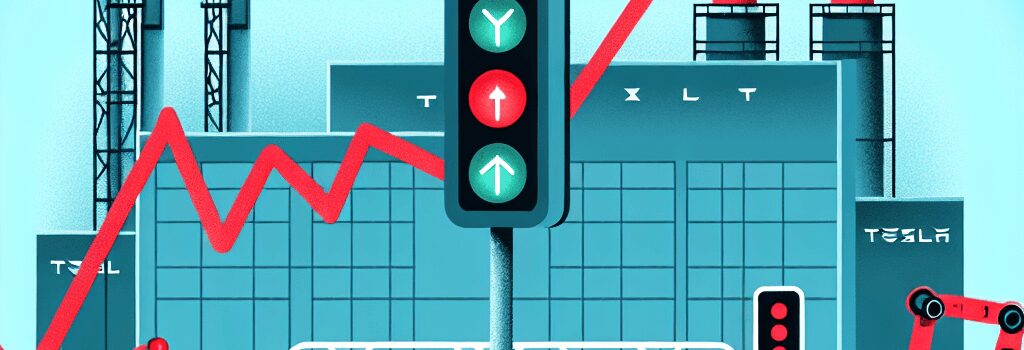Tesla Q1 2025: Plummeting Production and Sales Signal Deeper Industry Turbulence

Tesla’s recently released Q1 2025 numbers paint a troubling picture for a company historically celebrated for its rapid growth. The electric vehicle (EV) giant produced 362,615 vehicles from January through March 2025—a 16.3% drop compared to the same period in 2024. While sales figures showed a moderate decrease, delivering 336,681 EVs (a 12.9% decline), the overall trend suggests a need for urgent reassessment of Tesla’s forecasted demand and production alignment.
Impact on Core Models and Product Lines
Tesla’s business has long been dominated by the Models 3 and Y. In Q1 2025, production for these models totaled 345,454 units—a 16.2% decrease relative to the previous year. This decline was particularly evident for the Model Y, which recently underwent a significant refresh. Despite technical improvements such as enhanced battery management systems and updated infotainment features, Model Y sales saw a year-over-year drop of 12.4%, with only 323,800 units sold compared to 386,810 in Q1 2024.
In contrast, legacy models like the Model S and Model X, along with the frequently scrutinized Cybertruck, fared even worse. Collectively, their production plummeted by 18.3% to 17,161 units, with sales falling by 24.3% to 12,881 units. These figures underscore the competitive pressure on outdated designs and the challenges in revitalizing interest in products that have garnered recurring quality or design concerns.
Energy Storage and Diversification Strategies
On a slightly brighter note, Tesla’s energy storage division managed to deploy 10.4 GWh in Q1 2025. Although this segment remains a minor contributor to overall revenue, its steady growth hints at the company’s long-term strategy to diversify beyond automotive sales. In 2024, automotive sales contributed approximately 77% of Tesla’s revenue. The continued focus on energy storage, which includes products like the Powerwall and Megapack, is expected to bolster Tesla’s resilience amid fluctuating vehicle sales.
Technical Challenges and Operational Outlook
Delving into the technical side, several factors may have impacted Tesla’s performance this quarter. Supply chain disruptions, particularly in semiconductor availability and battery raw materials, have imposed new constraints on production capacities. Additionally, logistical challenges stemming from geopolitical factors and fluctuating raw material costs are adding layers of complexity to Tesla’s manufacturing and distribution processes.
Another technical concern involves aligning production with demand. Unlike previous years when production consistently exceeded demand, Tesla managed to synchronize these two elements more closely this quarter. This change, while reducing excess inventory, has also magnified the impact of even a slight downturn in consumer interest. Experts in automotive manufacturing suggest that incorporating advanced AI-driven logistics and real-time supply chain analytics could help Tesla preempt future production bottlenecks.
Market Sentiment and Investor Concerns
Market analysts were taken aback by these figures, with many forecasting Q1 deliveries between 360,000 and 370,000 units. The shortfall points to broader issues beyond manufacturing inefficiencies. In Europe, customer sentiment has soured significantly, largely fueled by growing opposition to CEO Elon Musk’s political engagements. Meanwhile, protests and vandalism at Tesla stores in the US indicate a shift in public perception regarding the company’s broader socio-political influence.
Financially, these challenges raise pressing questions. Tesla’s Q4 2024 profit margin had already been under scrutiny, standing at just 6.2%—roughly half the industry average for other automobile manufacturers such as Ferrari and Porsche. With investors closely watching these metrics, rumors of further margin impact and a potential risk of margin calls (with stock prices nearing the $114–$100 threshold) are becoming more prevalent. Despite these concerns, some investors appear to be betting on a rapid recovery, hinting at a possibility that Tesla might leverage its innovative prowess to overcome current obstacles.
Future Projections and Industry Implications
Looking ahead, the full story will unfold on April 22 when Tesla’s first-quarter financial results are officially published. Analysts predict that pending improvements in both production technology and supply chain management could gradually reverse these declining trends. In the meantime, industry experts are examining Tesla’s strategic adjustments, from diversifying its revenue streams to adopting cutting-edge production techniques.
Tesla’s trajectory is not only a reflection of its internal operations but also a bellwether for the broader EV market. As competitors enhance their technological offerings and expand market reach, Tesla will need to innovate continuously—both in hardware and in leveraging AI and machine learning to streamline operations—to maintain its edge in the increasingly competitive automotive landscape.
Conclusion
The Q1 2025 results serve as a stark reminder that even the most disruptive companies must navigate both market sentiment and operational challenges. With production hiccups, shifting consumer attitudes, and political controversies, Tesla’s key performance metrics have hit a rough patch. Industry stakeholders and technical experts alike are calling for enhanced technological integrations and more robust production planning as critical strategies moving forward.
- Production dropped by 16.3% compared to Q1 2024.
- Sales figures declined by 12.9%, with core models underperforming.
- Political controversies and supply chain issues are compounding the challenges.
- The energy storage segment, while growing, remains a small fraction of revenue.
- Future prospects hinge on improved technology integration and operational resilience.